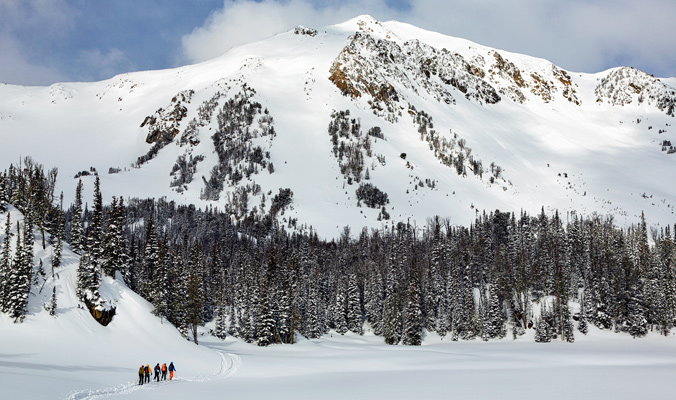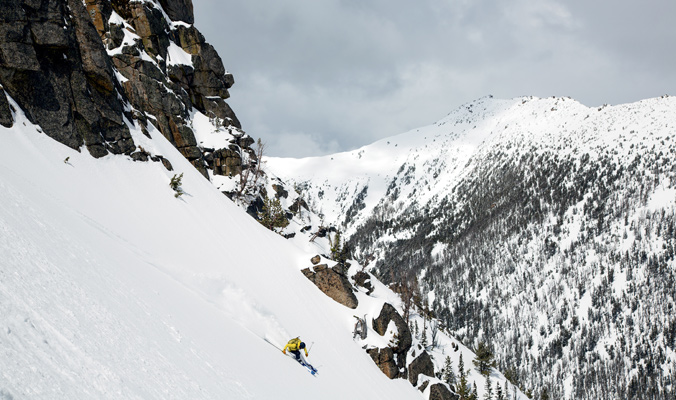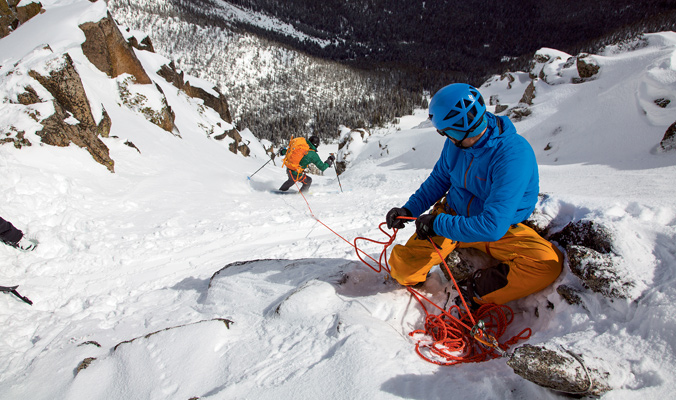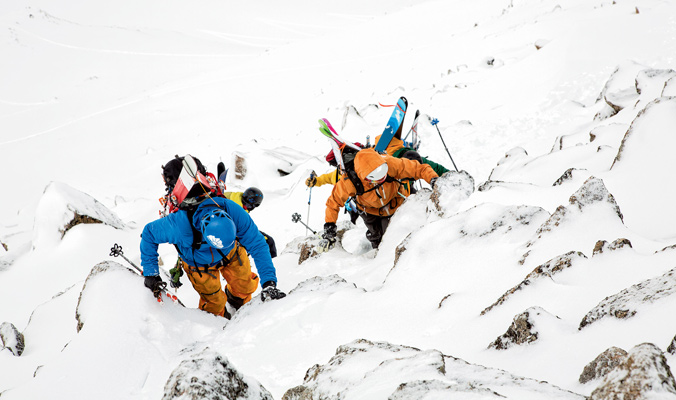Josh is out of control. Beneath gray skies and peaks shrouded in lightly falling snow, the splitboarder from Calgary, Alberta is accelerating face first down-slope, two hands firmly planted on his ice axe but unable to gain purchase in the 40-degree pitch. A Brazilian Jui-Jitsu instructor, he’s familiar with ground fighting, but he can’t quite grapple with this situation. Before he can arrest his momentum, he crashes, flailing like a test dummy, into a pile of soft debris.
“Josh, you’re dead,” his friend Greg shouts from above.
“I don’t know, man,” Josh yells back, snow caked to his black, close-cropped beard as though he just rode a line with faceshots at every turn. “I feel pretty alive.”
Josh is part of a quartet of Canadians who drove seven hours south from their Calgary home to Montana’s Tobacco Root Mountains two nights ago. Along with friends Brayden and Greg and Greg’s 13-year-old son Kai, Josh is here not just to feel alive in the mountains but to learn how to push higher into them. And how to arrest falls down them.

Nature’s classroom: Crossing Bell Lake in Montana’s Tobacco Root Mountains for Thompson Peak (10,386). [Photo] Simon Peterson
It’s the end of April, and the Tobacco Roots, a quiet range 45 miles dead west of Bozeman and sandwiched between the Madison and Jefferson Rivers, are still cloaked in a midwinter snowpack rather than layers of corn. But that doesn’t matter to the four Canadians, me or the three other skiers here at Big Sky Backcountry Guide’s (BSBG) second-annual ski-mountaineering camp. The terrain is teeming with steep routes and walled lines, some of which spill directly down to Bell Lake Yurt, our lodging and the indoor half of our classroom for four days.
One such commanding face is the north side of Branham Peak, rising more than 2,000 feet above the 2.6-mile approach to the yurt that sits just below its namesake Bell Lake. Depending on what you count, 11 couloirs spill down Branham’s face, from ski-width voids cutting through the rock to straight, wide ramps that beg to be tracked with high-speed GS turns. As we skinned beneath Branham on our approach, eyes transfixed on the possibilities above, Drew Pogge and Tucker Cunningham, our instructors for the course, spouted proverb-like one-liners about steep-skiing safety.

Instructors Drew Pogge and Tucker Cunningham dish up decision-making discussions with a side of breakfast burritos at Bell Lake Yurt. [Photo] Simon Peterson
“Ski mountaineering is an exercise in managing risk,” said Drew, the owner and lead guide for BSBG. “Ski mountaineering is a pessimist’s game. We’re always thinking about the worst that could happen.”
“There are no rules in backcountry skiing, only patterns,” mentioned Tucker, who splits his time guiding here and patrolling at Bozeman’s Bridger Bowl Ski Area. “What’s your level of experience, and what’s the terrain that matches up with it?”
“Is it a sledgehammer situation or is it a ball-pein hammer situation?” Drew commented later. He wrote an essay about such a metaphor for this magazine several years back, an editor’s note with a right-tool-for-the-job message about using a miniature sledgehammer to hang a photo, destroying some sheetrock in the process. It wasn’t our mutual affinity for hammers, however, or my propensity for choosing the wrong tool for the job that brought me to this course. Rather, it was my and Drew’s complementary paths editing Backcountry.

The author gets down with midwinter conditions in April in Branham Peak’s Son of Kona couloir. [Photo] Simon Peterson
For the first several years of my career, I worked beneath Drew, following his lead when it came to writing and editing. So while ski-mountaineering courses have proliferated widely across the U.S. in recent years, Big Sky’s would provide me the chance to literally learn the ropes from somebody who’d already taught me much. And even though my job has afforded me opportunities to ski steeps around the world, I wanted to refine and practice those skills in a constructive, focused setting. The other seven students had similar ambitions.
In addition to the Canadians, this crew came from Bozeman and places eastward. Jon, who’s lived in Montana for two years after college in Vermont, works for the USGS and wants to learn more about his new zone and meet some partners. Reed, from Michigan, is relatively new to backcountry skiing, approaching his education with the studious inquiry that no doubt led him to become an engineer with Corvette Racing. Mark, who splits his time between Philadelphia and Big Sky, just ended a 30-plus-year career in the pharmaceutical industry and dreams of spending his retirement in the backcountry.
It’s a wide-ranging cross section of the sport. But we’re all here to progress our skiing and riding, building on what we know to learn new skills that can take our pursuits a step further.

Reed Sullivan learns the ropes atop Branham’s Son of Kona. [Photo] Simon Peterson
The outhouse at Bell Lake Yurt is a stick-framed, three-sided shed wrapped in brown and green tarps and mounded to the roof with a thick winter’s snowpack. From the toilet-seat-topped chipboard box, the view could be a picture window, framing Branham Peak’s north-facing couloirs beneath roof beams of forearm-size logs and evergreens sticking 20 feet above the snow. This morning, clouds cloak Branham’s summit, below which patches of 2,000-foot snow-filled steeps emerge from folds in the rock.
All that’s hidden from view, however, as we skin up the Green Room, a broad bowl tucked behind a towering rock prow that separates our morning ascent route from the north couloirs.
“What’s that, Tucker?” Drew asks through his radio mic, after an indecipherable transmission breaks the morning’s quiet.
“Oh, I was just using valuable radio waves to comment, ‘Holy cow, what a beautiful morning it is,’” Tucker says, following our group, with Team Canada a few hundred feet below.
“Copy that. Affirmative,” Drew adds. Indeed, the morning’s crisp clarity is striking. Low clouds swirl throughout Bell Lake’s basin, contrasting with the high ceiling above, occasionally broken by sucker holes that cast sunshine onto nearby Thompson Peak, striped with point-release sluffs and tracks from where we had practiced various self-arrest techniques, crampon use and defensive-skiing skills yesterday. The valley is silent, save for the distant chatter of the other group below.
“The last time this ran climax, that I’m aware of, was 2001,” Drew says below the rock prow, where we gather to discuss the Green Room’s bowl and slidepath. “It put debris across the lake and broke through the ice—it’s definitely big terrain. How do we want to approach this?”
Jon points out a rock moraine that we could travel underneath, protected from hazards above. Reed mentions the slope angle that’s teetering around 35 degrees and addresses possible slab concerns with the snow that fell two nights back. So we choose to work the bowl’s left side, protected from the upper slope and start zone, and we’ll reassess above. But the slab never materializes, and we confidently gain Branham’s rocky ridge and, while regrouping, strap skis to packs.
Kai is the second to drop into Backdoor, following Tucker’s lead down the arrow-straight couloir that’s blanketed in creamy snow peppered by small rocks at its margins. An orange rope trails from beneath his sagging, camoflauge jacket, secured to Drew’s single-ski anchor atop the line. On belay, Kai slowly crosses the slope before his five-foot frame fully unweights and reverses direction, repeating the rhythm with greater control at each turn before arriving at the rope’s end.
“All right, Kai. Nice job. You can unclip,” Drew says from his belay perch while the rest of us applaud with pole clicks to affirm the 13-year-old’s confident hop turns. He comfortably arcs a half dozen more turns through the soft snow to where Tucker waits below as Brayden ties in, then Greg, then Josh.
With the first group safely into their line, the rest of us continue up Branham’s ridge for Son of Kona, a line with angled walls that pinches like an hourglass a few turns down. Side slipping the uppermost section seems possible, but everyone’s already wearing harnesses, and a rope will provide extra security, so we elect to ski into the line on belay. I drop in first, linking tight, controlled turns, mindful of the slight tug at my waist and appreciating the comfort it affords through the narrow constriction.
Off belay, I stomp out a platform out of sight and tucked beneath a cliff while Reed descends, unclips and skis up to me. “This is sweet,” he says with childlike excitement. “This is what I was hoping for.”
“It’s funny,” Jon says when he slides in beneath us. “I get so nervous at the top of these things, but as soon as I make a turn it’s like, ‘Oh. I’ve been doing this for 20 years.’”
Neither have skied in harnesses or with ropes before, but this kind of skiing represents specifically what they came here for. From where we stand, everything below—the soft, stable snow, the wide slope, the moderate angle—feels entirely familiar. Yet without the belay through the hourglass, such a route would have been out of reach.

Drew Pogge leads the way toward higher learning on Branham Peak. [Photo] Simon Peterson
“I mean, I could ski 30-degree powder slopes for the rest of my life,” Reed says, “but the challenge to get into steeper stuff, to learn the tools, is what draws me.”
Jon echoes that sentiment, mentioning that he’s keen to develop his skill set to access more challenging terrain, when we notice a pair of mountain goats across the slope. High above the couloir, their tracks, stuck like magnets to a refrigerator, wind between thin ledges and snow patches that appear vertical.
“What do you think they’re doing?” Reed asks, “Like what’s their goal?” I wonder if they’re looking down upon us, similarly curious about our motivations.
“OK, now that’s cool,” Mark says moments later, breaking our silence after completing his belayed ski. “That’s why I brought matches, though. I might need to burn these undershorts after.”
More than just Mark’s nerves are on edge after lunch. Rappelling off a pair of skis anchored 18 inches deep in the snow, he wobbles like an unsteady pendulum atop a sheer drop. Then he plants both boots on the rocky edge, leans into a seated position and, with each downward step, breathes heavily and deliberately like a weightlifter.
Twenty feet later, Mark exhales loudly, this time a sigh of relief as he contacts firm, horizontal footing. “Well, I didn’t crap myself,” he says, cracking a smile mixed with excitement and relief.
Mark’s energy is inspiring. The 60-year-old spent more than 30 years managing quality control at Merck, one of the world’s largest pharmaceutical companies, a career that, I’d imagine, could fund a retirement filled with heli-skiing holidays. But he chose instead to dive into ski mountaineering. This course is his starting point, and he says he dreams of spending the fittest years of his retirement learning more about steep skiing.
“I just really want to push myself out of my comfort zone with mental and physical challenges,” he says once unclipped from the rappel. “I’ve done the mental stuff with my job—I had a staff of 500—so I wanted to take on the physical. I see this as a platform to do more. I’m drinking from the fire hose.”

Testing the strength of a T-trench anchor. The verdict? It’ll do. [Photo] Simon Peterson
It’s a youthful outlook, not much different from that of Kai, who’s young enough to be one of Mark’s six grandkids. And while their approach transcends generations, it’s also why I think ski mountaineering and these types of courses are gaining so much interest. On one hand, pushing into steeper terrain represents a logical, outward progression, a physical pursuit bent on seeking whatever objective is next, bigger and bolder. But there’s also an inward and exciting challenge in acquiring and practicing these skills, in learning when and how to use them. That process, quite simply, is the internal and ongoing equivalent of skiing steep lines.
Murky fog enveloping the yurt on our fourth and final morning is the least of our weather concerns. Yesterday’s brief afternoon sun during rappel practice glazed southern and westerly faces before temperatures dropped, loading wind-whipped snow onto aspects north through east. The compass is a minefield, unstable on some aspects and unsavory on others. But this morning is our chance to put together everything we’ve learned.
The crew divides in two, and my group skins past Bell Lake through a dense forest toward a line that Drew calls Copperhead Road. “It’s usually an s-curved couloir,” he says, “but it’s pretty filled in.”
Indeed, when we emerge from the evergreens, the ceiling is lifting above a broad, north-facing slope that looks more like a bowl than a couloir. Digging into a protected slope reveals loose, dry snow; no slab, no crust. So we ascend the line’s edges, switchbacking through consistent, shin-deep powder. Near the ridge that divides Bell Lake Cirque and an unnamed basin to its south, we mount skis to our packs and climb over granular snow and fractured granite for Copperhead’s top.
There, with the wind at our backs, we discuss the line and the safest way to ski it—Drew first, cutting the start zone and posting up at a perch on the right while the rest of us descend one by one. I opt to ski last.
The first several turns send powder billowing over my shoulders before I settle into a rhythm, bouncing measured, medium-radius tracks into the buoyant, supportive snow. I wouldn’t exactly consider this steep skiing; the line doesn’t dangle over exposure nor does it pitch downward at a daunting angle. But finding a safe and skiable route amid today’s adverse conditions required plenty of skills newly added to our toolboxes. And if these turns weren’t a sufficient reward, the process of getting here would be satisfying enough.










Related posts:
Beyond the Gates: How the BRASS Foundation is teaching racers avy safety
2019 Skills Guide: The Level Four Experience
How one Crested Butte-based skier pays it forward
The Skills Guide: Four Steps Toward Enlightenment